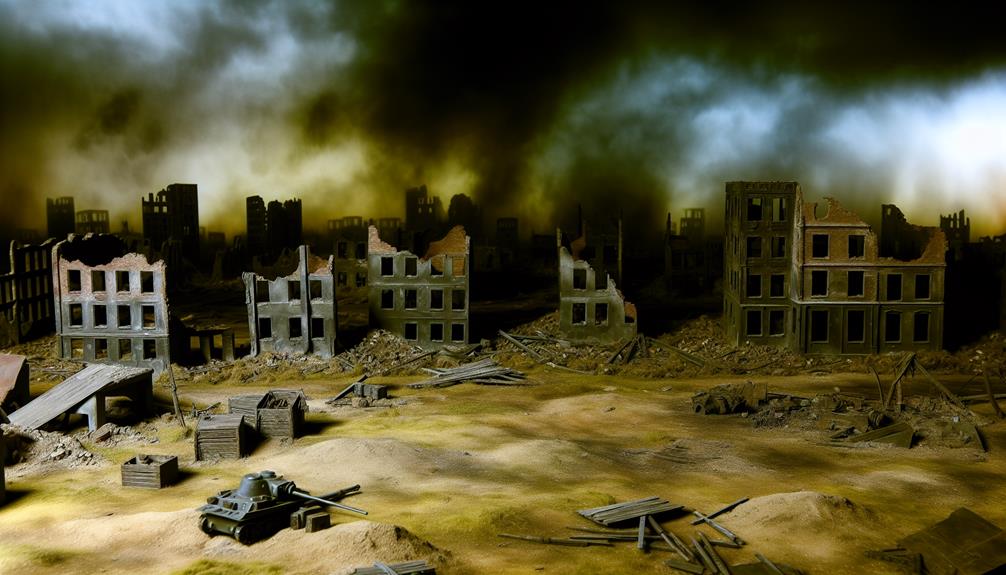The Battle of Stalingrad stands as a testimony to the intricate interplay of military strategy, human resilience, and historical significance. The brutal urban warfare that unfolded on the banks of the Volga River not only shaped the outcome of the Eastern Front but also left an indelible mark on the collective memory of nations involved in the conflict. As the battle raged on, pivotal decisions were made, sacrifices were immense, and the fate of empires hung in the balance. The events that transpired in Stalingrad continue to intrigue scholars and historians alike, offering a glimpse into the complexities of war and the enduring legacy of those who fought on both sides.
Key Takeaways
- Soviet resilience and determination weakened German forces.
- Strategic blunders by German High Command weakened their position.
- Division of German forces favored the Soviets.
- Innovative Soviet tactics and offensives shifted momentum.
- Stalingrad victory marked a turning point in defeating Nazi Germany.
Prelude to Stalingrad
In the lead-up to the historic battle of Stalingrad, a series of strategic maneuvers and escalating tensions between the Soviet Union and Nazi Germany set the stage for one of the most pivotal confrontations of World War II. German strategy leading to the Battle of Stalingrad aimed to secure the southern flank of the Eastern Front, control the crucial oil fields in the Caucasus region, and eliminate the industrial capacity of the city itself. The German forces, under the command of General Friedrich Paulus, were confident in their ability to quickly overcome Soviet resistance and capture the city, which bore the name of the Soviet leader, Joseph Stalin.
On the other hand, Soviet resistance was fueled by a deep-seated determination to defend their homeland against the invading German forces. The Red Army, under the strategic direction of Marshal Georgy Zhukov, prepared to confront the German offensive with a mix of tenacity, resilience, and a willingness to endure tremendous sacrifices. The Soviet defenders were well aware of the strategic importance of Stalingrad, not just with regards to its industrial capacity but also for its symbolic value as a city named after their leader.
As German forces advanced, encountering fierce Soviet resistance along the way, the stage was set for a brutal and protracted battle that would ultimately change the course of the war in the East.
The Siege Begins
As German forces closed in on Stalingrad, the city's fate hung in the balance as the initial stages of the siege began to unfold. The siege of Stalingrad, which commenced in August 1942, marked a critical phase in the Eastern Front of World War II. German forces, under the command of General Friedrich Paulus, implemented aggressive siege strategies to encircle and isolate the city, aiming to crush Soviet resistance and secure a decisive victory. The Germans, facing mounting pressure to achieve a swift conquest, exhibited signs of desperation as they sought to break the will of the Soviet defenders.
To cut off the city from crucial supply lines, the Germans focused on severing transportation routes and tightening their grip around Stalingrad. This approach aimed to starve the city of essential resources, weaken its defenses, and force a surrender. Additionally, German air raids targeted key infrastructure and civilian areas, intensifying the suffering of the inhabitants and undermining morale.
Despite the German onslaught, Soviet forces, led by General Vasily Chuikov, displayed resilience and determination in the face of overwhelming odds. The strategic positioning of Soviet troops within the city's ruins and their ability to adapt to the urban warfare environment posed significant challenges for the German invaders. The stage was set for a protracted and brutal battle that would test the resolve of both sides in the crucible of Stalingrad.
Turning the Tide
Amidst the relentless bombardment and fierce urban combat, pivotal developments emerged that would gradually shift the momentum in the battle for Stalingrad. The Soviet resilience in the face of overwhelming odds played a significant role in turning the tide against the German forces. Despite initial setbacks and strategic blunders, the Soviets displayed remarkable determination and adaptability, ultimately leading to a change in the course of the battle.
To illustrate the evolving dynamics of the conflict, the table below highlights key factors contributing to the turning point at Stalingrad:
| Factors | Description |
|---|---|
| Soviet Resilience | The unwavering determination and courage exhibited by the Soviet soldiers |
| in defending their city against the German onslaught. | |
| Strategic Blunders | Mistakes made by the German High Command, such as overextension of supply |
| lines and underestimation of Soviet resistance, leading to vulnerabilities. |
The Soviet resilience not only bolstered their defense but also demoralized the German troops facing an increasingly determined enemy. Meanwhile, the strategic blunders made by the German forces, including the decision to divide their forces and spread them thin across the city, played into the hands of the Soviets. These combined factors gradually shifted the momentum in favor of the Red Army, setting the stage for the eventual turnaround in the Battle of Stalingrad.
The Red Army's Triumph
The culmination of strategic maneuvers and unwavering determination resulted in the Red Army's triumph at Stalingrad. The Red Army's success was not a stroke of luck but a testament to their meticulous planning and execution. Here are four key factors that contributed to the Red Army's triumph:
- Soviet Strategy: The Red Army's strategic planning played a pivotal role in their victory at Stalingrad. Through innovative tactics such as encirclement maneuvers and coordinated offensives, the Soviet forces were able to outmaneuver the German army, turning the tide of the battle in their favor.
- Unity and Resilience: The Red Army's ability to maintain unity and resilience in the face of adversity was instrumental in their triumph. Despite facing heavy casualties and intense fighting, the Soviet troops remained steadfast and focused on their objective, eventually wearing down the enemy.
- Supply Lines: The Red Army's effective management of supply lines ensured that their troops were adequately equipped and provisioned throughout the battle. This logistical advantage gave the Soviet forces the necessary resources to sustain their offensive and ultimately emerge victorious.
- Strategic Leadership: The Red Army's leadership, under figures like Marshal Georgy Zhukov, demonstrated exceptional skill and foresight in guiding their forces to victory. By making decisive decisions and adapting their strategies to the evolving battlefield, the Soviet commanders played a critical role in the Red Army's triumph at Stalingrad.
Aftermath and Legacy
Upon the conclusion of the pivotal battle at Stalingrad, the aftermath and legacy that ensued bore significant implications for both the Soviet Union and the course of World War II. The city of Stalingrad lay in ruins, with almost 2 million people dead, injured, or missing. The Soviet Union faced immense challenges in rebuilding efforts, needing to reconstruct not only the physical infrastructure but also the shattered morale of its people.
In the aftermath of the battle, Stalingrad became a symbol of Soviet resilience and victory, a reflection of the unwavering determination of the Red Army and the Soviet people. The sacrifices made in Stalingrad were commemorated through the construction of numerous war memorials, serving as a reminder of the high price paid for victory and the heroic deeds of those who fought there.
The legacy of Stalingrad extended beyond the war itself, shaping the Soviet Union's identity and its role in the post-war world. The Soviet victory at Stalingrad marked a turning point in the Eastern Front, halting the seemingly unstoppable advance of the German army and paving the way for subsequent Soviet offensives that would ultimately lead to the defeat of Nazi Germany.
Frequently Asked Questions
How Did the Civilians in Stalingrad Cope During the Siege?
During the siege of Stalingrad, civilians displayed remarkable survival strategies and psychological resilience. Facing extreme adversity, the inhabitants of the city utilized various coping mechanisms to endure the harsh conditions of the siege.
Their ability to adapt, maintain hope, and support one another played a pivotal role in their ability to persevere through the challenging circumstances.
The civilians of Stalingrad demonstrated extraordinary strength and perseverance in the face of overwhelming challenges.
What Role Did Weather Conditions Play in the Battle?
Weather conditions played a pivotal role in the battle of Stalingrad, impacting combat strategies and the overall outcome. Harsh winters with freezing temperatures and heavy snowfall slowed down movements, affected visibility, and made supplies scarce.
Both Axis and Soviet forces had to adapt to these conditions, with winter gear becoming essential for survival. The weather became a formidable adversary, shaping tactics and ultimately influencing the course of the battle.
Were There Any Notable War Tactics Used by the Soviets?
In examining Soviet strategies during the Battle of Stalingrad, notable urban warfare tactics were employed.
The Soviets utilized innovative tactics such as establishing strong defensive positions within the city, creating a labyrinth of interconnected trenches and tunnels to ambush the enemy.
They also incorporated sniper teams to disrupt enemy movements and morale.
These urban warfare strategies played a pivotal role in the eventual Soviet victory at Stalingrad.
How Did Stalingrad Impact the Morale of the Axis Powers?
The impact of the Stalingrad siege on the morale of the Axis powers was profound. The relentless resistance shown by the Soviet forces and the civilian population showcased a level of resilience that deeply shook the confidence of the Axis forces.
Witnessing the fierce determination of the defenders in the face of overwhelming odds played a significant role in undermining the morale of the Axis powers and contributed to a shift in the momentum of the Eastern Front.
What Were the Long-Term Effects of the Battle of Stalingrad on Wwii?
The Battle of Stalingrad had significant long-term effects on WWII. Post-war repercussions included a shift in military strategies, with a realization of the importance of urban warfare and the impact of attrition on resources.
The defeat of the Axis powers at Stalingrad marked a turning point in the Eastern Front, leading to a series of subsequent Soviet offensives that ultimately pushed the Germans back and contributed to the downfall of Nazi Germany.
Conclusion
To summarize, the Battle of Stalingrad stands as a testimony to the resilience and strategic prowess of the Soviet forces during World War II.
One compelling statistic that highlights the intensity of the battle is the staggering number of casualties on both sides, with over 2 million soldiers and civilians perishing during the brutal conflict.
This grim toll underscores the ferocity of the fighting and the immense sacrifices made in the pursuit of victory.


